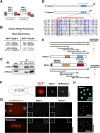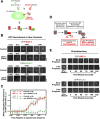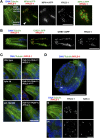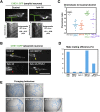The hydrolethalus syndrome protein HYLS-1 links core centriole structure to cilia formation
- PMID: 19656802
- PMCID: PMC2751977
- DOI: 10.1101/gad.1810409
The hydrolethalus syndrome protein HYLS-1 links core centriole structure to cilia formation
Abstract
Centrioles are subcellular organelles composed of a ninefold symmetric microtubule array that perform two important functions: (1) They build centrosomes that organize the microtubule cytoskeleton, and (2) they template cilia, microtubule-based projections with sensory and motile functions. We identified HYLS-1, a widely conserved protein, based on its direct interaction with the core centriolar protein SAS-4. HYLS-1 localization to centrioles requires SAS-4 and, like SAS-4, HYLS-1 is stably incorporated into the outer centriole wall. Unlike SAS-4, HYLS-1 is dispensable for centriole assembly and centrosome function in cell division. Instead, HYLS-1 plays an essential role in cilia formation that is conserved between Caenorhabditis elegans and vertebrates. A single amino acid change in human HYLS1 leads to a perinatal lethal disorder termed hydrolethalus syndrome, and we show that this mutation impairs HYLS-1 function in ciliogenesis. HYLS-1 is required for the apical targeting/anchoring of centrioles at the plasma membrane but not for the intraflagellar transport-dependent extension of the ciliary axoneme. These findings classify hydrolethalus syndrome as a severe human ciliopathy and shed light on the dual functionality of centrioles, defining the first stably incorporated centriolar protein that is not required for centriole assembly but instead confers on centrioles the capacity to initiate ciliogenesis.
Figures







References
-
- Altun-Gultekin Z, Andachi Y, Tsalik EL, Pilgrim D, Kohara Y, Hobert O. A regulatory cascade of three homeobox genes, ceh-10, ttx-3 and ceh-23, controls cell fate specification of a defined interneuron class in C. elegans. Development. 2001;128:1951–1969. - PubMed
-
- Arts HH, Doherty D, van Beersum SE, Parisi MA, Letteboer SJ, Gorden NT, Peters TA, Marker T, Voesenek K, Kartono A, et al. Mutations in the gene encoding the basal body protein RPGRIP1L, a nephrocystin-4 interactor, cause Joubert syndrome. Nat Genet. 2007;39:882–888. - PubMed
Publication types
MeSH terms
Substances
Grants and funding
LinkOut - more resources
Full Text Sources
Other Literature Sources
Molecular Biology Databases
Research Materials
